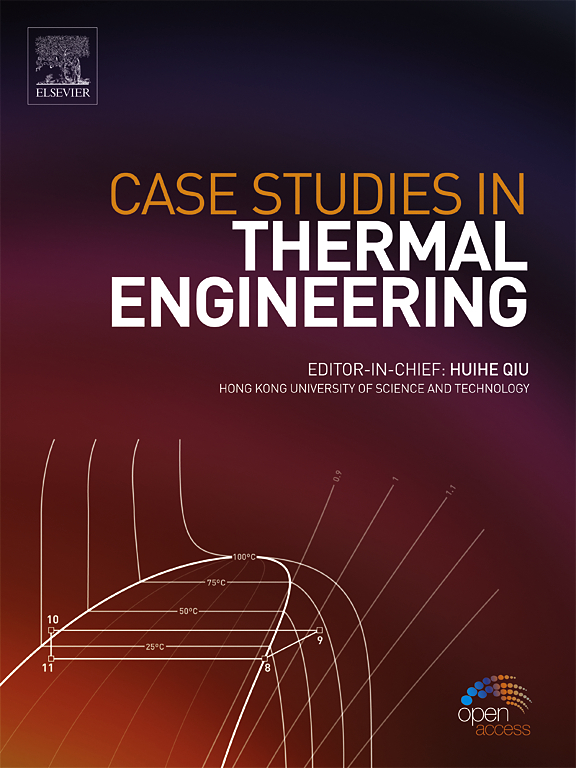利用墙壁和屋顶上的 PCM 和光伏电池提高沙特阿拉伯建筑的发电量,打造可持续建筑
IF 6.4
2区 工程技术
Q1 THERMODYNAMICS
引用次数: 0
摘要
在沙特阿拉伯,大部分地区接收的最低入射短波太阳能超过 4 kWh/(m2.年),因此发电潜力巨大,同时在建筑制冷方面也面临挑战。在这项研究中,通过在屋顶和墙壁上增加光伏(PV)以及在墙壁内使用相变材料(PCM),对沙特住宅建筑的发电量和能耗进行了调查。考虑到辐射对垂直和水平围护结构的影响以及 PCM 的相变,使用 DesignBuilder 求解了能源方程,以确定每小时的能耗和发电量。当以最佳倾斜度安装光伏电池时,进入电池的辐射会增加。然而,在随后几排电池上形成阴影会减少有效的光伏表面积。令人惊讶的是,计算显示,如果以零角度安装光伏电池,由于安装了更多的光伏电池,发电量比以最佳倾斜角度安装时多 31%。同时,由于屋顶的辐射强度降低,制冷负荷也减少了 5.1%。墙壁的朝向对相变材料 (PCM) 和光伏发电都有很大影响。将相变材料置于东墙可优化其性能,而装有光伏板的墙面朝南时性能最佳。为了进一步提高冷却效果并减少电力需求,屋顶和墙壁都采用了相变材料,从而使总体电力需求减少了 2%。值得注意的是,在沙特阿拉伯的八个主要人口稠密地区,在光伏电池面积不变的限制条件下,将光伏电池安装在屋顶比安装在墙壁上的优势高出三倍。本文章由计算机程序翻译,如有差异,请以英文原文为准。
Boosting electricity generation associated with Saudi Arabi buildings using PCM and PV cells on walls and roof leading to a sustainable building
In Saudi Arabia, where the majority of regions receive a minimum incident shortwave solar energy exceeding 4 kWh/(m2. year), there is a high potential for electricity generation and simultaneously, a challenge in building cooling. In this study, by adding photovoltaic (PV) on the roof and wall, as well as using phase change material (PCM) inside the walls, electricity production and energy consumption of Saudi residential buildings were investigated. Taking into account the effects of radiation on vertical and horizontal envelopes as well as phase change in PCM, the energy equation was solved using DesignBuilder to specify hourly energy consumption and electricity generation. When installing PV cells at the optimal tilt, incoming radiation to the cells increases. However, creating shadows on subsequent rows of cells diminishes the effective PV surface area. Surprisingly, calculations revealed that if PV cells are installed at zero angle, owing to installing more PV cells, up to 31 % extra electricity is produced than when installed at the optimal tilt. As a side effect, the cooling load decreases by 5.1 % due to reduced radiation intensity on the roof. The orientation of the walls significantly impacts both phase change material (PCM) and PV-associated electricity generation. Placing PCM on the east wall optimizes its performance, while walls containing PV panels perform best when facing south. To further enhance cooling and reduce electricity demand, phase change material was incorporated into both the roof and wall, resulting in a 2 % reduction in overall electricity demand. Notably, in eight major populated areas across Saudi Arabia, under the constraint of the constant PV cell area, installing PV cells on the roof proves three times more advantageous than placing them on the walls.
求助全文
通过发布文献求助,成功后即可免费获取论文全文。
去求助
来源期刊

Case Studies in Thermal Engineering
Chemical Engineering-Fluid Flow and Transfer Processes
CiteScore
8.60
自引率
11.80%
发文量
812
审稿时长
76 days
期刊介绍:
Case Studies in Thermal Engineering provides a forum for the rapid publication of short, structured Case Studies in Thermal Engineering and related Short Communications. It provides an essential compendium of case studies for researchers and practitioners in the field of thermal engineering and others who are interested in aspects of thermal engineering cases that could affect other engineering processes. The journal not only publishes new and novel case studies, but also provides a forum for the publication of high quality descriptions of classic thermal engineering problems. The scope of the journal includes case studies of thermal engineering problems in components, devices and systems using existing experimental and numerical techniques in the areas of mechanical, aerospace, chemical, medical, thermal management for electronics, heat exchangers, regeneration, solar thermal energy, thermal storage, building energy conservation, and power generation. Case studies of thermal problems in other areas will also be considered.
 求助内容:
求助内容: 应助结果提醒方式:
应助结果提醒方式:


